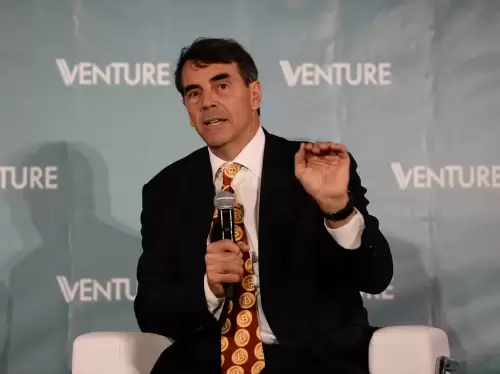 |
|
 |
|
 |
|
 |
|
 |
|
 |
|
 |
|
 |
|
 |
|
 |
|
 |
|
 |
|
 |
|
 |
|
 |
|
Cryptocurrency News Articles
How Market Makers Manipulate Cryptocurrency Prices
Mar 26, 2025 at 10:30 pm
Kain Warwick, the co-founder of the decentralized derivatives platform Synthetix, has shed light on what he describes as the deceptive tactics

Kain Warwick, the co-founder of decentralized derivatives platform Synthetix, has shed light on what he describes as the deceptive tactics employed by market makers (MMs) to manipulate cryptocurrency prices.
In a detailed post on X, Warwick recounted the evolution of these entities, from their initial role in facilitating exchange listings to orchestrating intricate price schemes that often leave retail investors holding devalued assets as exit liquidity.
During the initial coin offering (ICO) boom, Warwick noted that projects were typically required to pay market makers substantial fees, ranging from $50,000 to $300,000 per month, to secure listings on cryptocurrency exchanges and attract significant investors. He pointed out that without these often costly deals, it was nearly impossible for emerging projects to secure the necessary capital and exchange listings.
However, Warwick highlighted that as early as 2017, some market makers began to shift their focus towards more manipulative tactics.
Instead of prioritizing genuine liquidity provision, these MMs allegedly started artificially inflating trading volumes on smaller, lesser-known exchanges while strategically avoiding scrutiny on major platforms like Binance and Kraken.
Warwick explained how market makers began using call option structures to profit from price manipulation.
Rather than providing genuine liquidity to the market, these MMs would allegedly engage in tactics to artificially pump up the prices of tokens. Once the price reached a certain level, they would exercise their call options and then quickly dump their holdings onto the market for profit.
The low float strategy, which involves launching a token with a limited number of coins initially available for trading, and which gained popularity through figures like Sam Bankman-Fried, further amplified the value and effectiveness of these manipulative call option schemes.
With fewer tokens in circulation at the time of launch, market makers could exert more control over the price action.
They would allegedly sell into market bids to create artificial buying pressure, short the token to further drive down the price, and then buy back their positions at lower prices, ensuring maximum profits from these orchestrated price swings.
According to Warwick, projects now sell discounted tokens to liquidity funds before their Token Generation Event (TGE).
These funds then agree to bid strategically on the market, creating a false impression of strong demand for the token.
Simultaneously, a large portion of tokens is sent to exit-strategy MMs, who then proceed to dump these tokens into the artificially inflated market.
This cycle enables MMs and early investors to exit with profits while leaving retail buyers holding devalued tokens. Warwick cautioned that large token transfers to market makers should be viewed as a red flag, potentially indicating such manipulative schemes are underway.
Warwick expressed his disdain for these tactics, emphasizing that a legitimate market maker should focus on providing liquidity with tight bid-ask spreads rather than manipulating prices. He urged investors to demand greater transparency from projects engaging with MMs.
He also revealed that Synthetix was among the first projects to be exploited by DWF Labs.
Warwick stated that DWF Labs purportedly purchased treasury tokens from Synthetix, engaged in activities to pump the price in a low-liquidity environment, and then dumped their holdings for profit, leaving Synthetix and its community to deal with the consequences.
Disclaimer:info@kdj.com
The information provided is not trading advice. kdj.com does not assume any responsibility for any investments made based on the information provided in this article. Cryptocurrencies are highly volatile and it is highly recommended that you invest with caution after thorough research!
If you believe that the content used on this website infringes your copyright, please contact us immediately (info@kdj.com) and we will delete it promptly.
-

-

-

- XRP price has increased by more than 3% in the last 24 hours and is now trying to climb above the important $2.60 level
- May 14, 2025 at 10:45 am
- A bearish signal that had been hanging over the market for months has finally been invalidated. Since the start of the year, analysts were watching a bearish divergence play out — but now, XRP's RSI on the 3-day chart has made a higher high.
-

-
![After a notable 50% rally, Dogecoin [DOGE] appears to be consolidating near the key resistance level of $0.25 After a notable 50% rally, Dogecoin [DOGE] appears to be consolidating near the key resistance level of $0.25](/assets/pc/images/moren/280_160.png)
-

-

-

-
![Pi Network [PI] has remained bullish in recent weeks, gaining 51.26% over the past month and rallying 92.17% in the past week alone. Pi Network [PI] has remained bullish in recent weeks, gaining 51.26% over the past month and rallying 92.17% in the past week alone.](/assets/pc/images/moren/280_160.png)
- Pi Network [PI] has remained bullish in recent weeks, gaining 51.26% over the past month and rallying 92.17% in the past week alone.
- May 14, 2025 at 10:30 am
- This bullish movement has reached a critical point, with PI trading within a key level. An upcoming ecosystem update could significantly impact the asset's price.























































![After a notable 50% rally, Dogecoin [DOGE] appears to be consolidating near the key resistance level of $0.25 After a notable 50% rally, Dogecoin [DOGE] appears to be consolidating near the key resistance level of $0.25](/uploads/2025/05/14/cryptocurrencies-news/articles/notable-rally-dogecoin-doge-appears-consolidating-key-resistance-level/image_500_300.webp)

![Pi Network [PI] has remained bullish in recent weeks, gaining 51.26% over the past month and rallying 92.17% in the past week alone. Pi Network [PI] has remained bullish in recent weeks, gaining 51.26% over the past month and rallying 92.17% in the past week alone.](/uploads/2025/05/14/cryptocurrencies-news/articles/pi-network-pi-remained-bullish-weeks-gaining-month-rallying-week/image_500_300.webp)